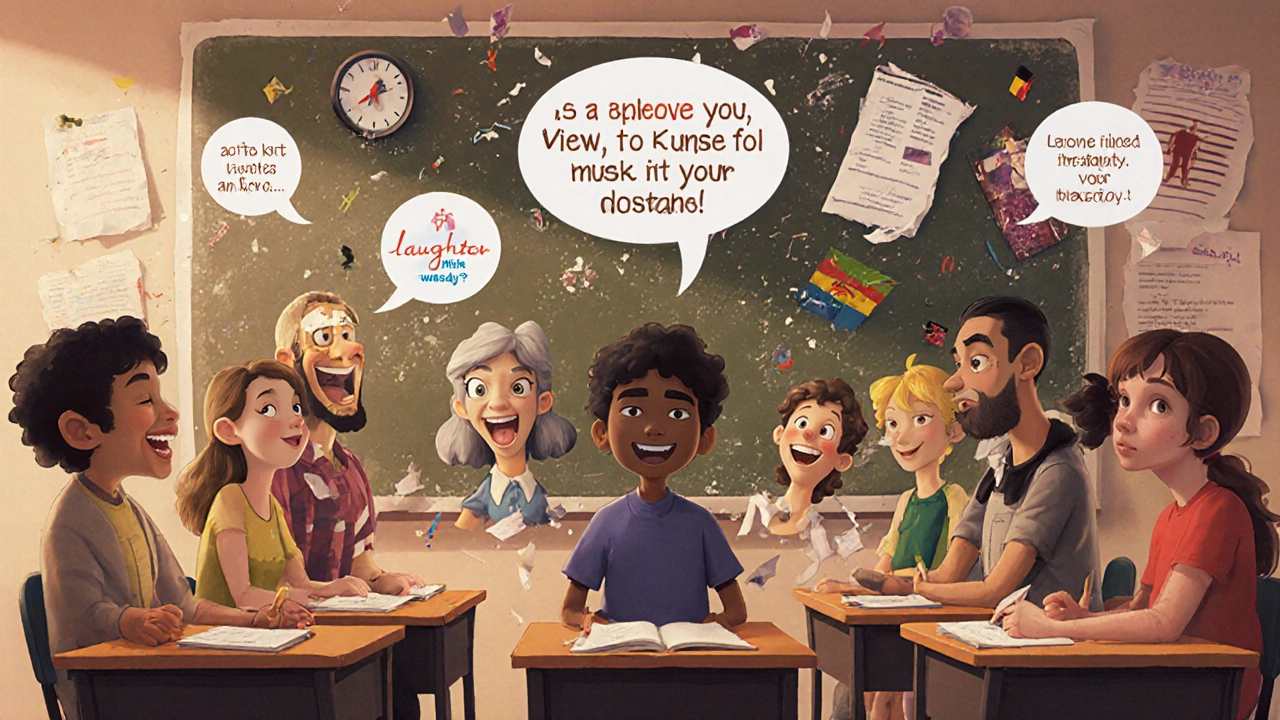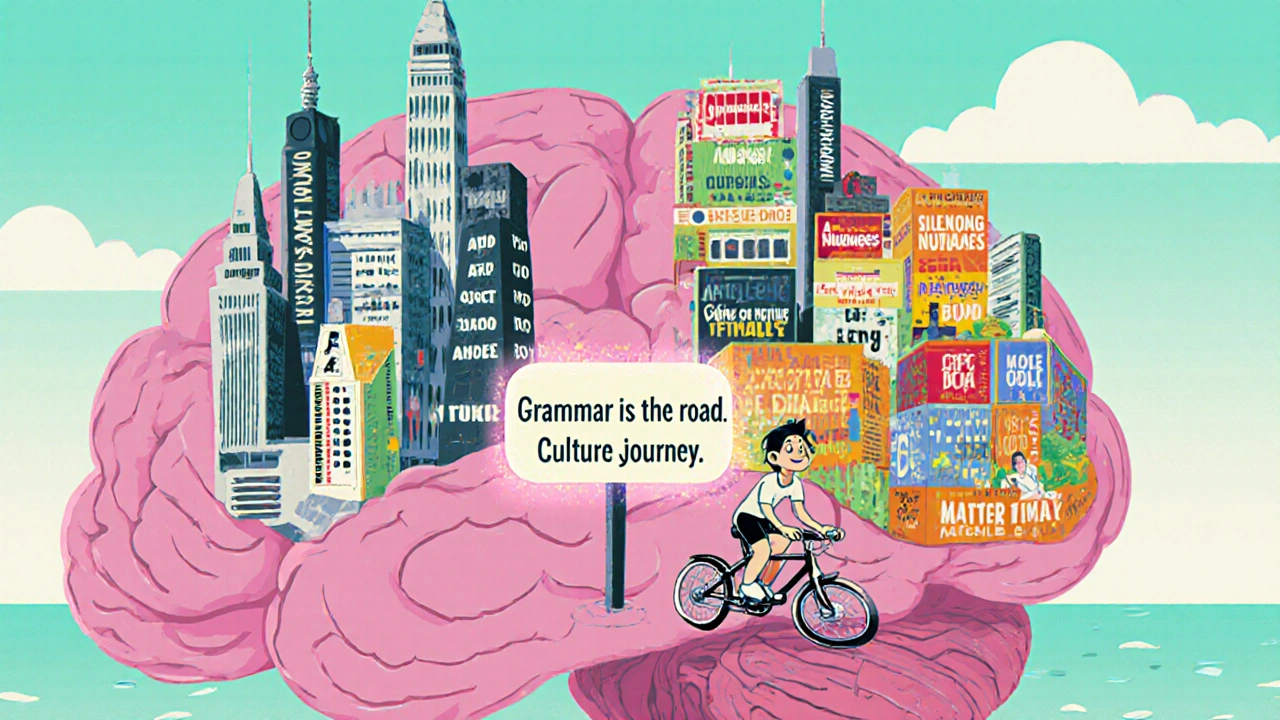Culture and Context in Language Education: Teach Beyond Grammar
 Oct, 25 2025
Oct, 25 2025
Think about the last time you tried to say something in a new language-and got laughed at. Not because you messed up the verb conjugation, but because you used the wrong word for ‘friend’ in a business meeting. Or you asked someone how much they weigh at a dinner party. Or you said ‘I love you’ to your host’s aunt thinking it was polite. These aren’t grammar mistakes. They’re cultural ones. And they happen every day in language classrooms that only teach rules.
Why Grammar Alone Doesn’t Get You Through the Door
Most language courses start with verbs, tenses, and sentence structure. That’s fine. But if you only learn grammar, you’re learning how to build a car-without ever being told where to drive it. You can conjugate ‘to be’ perfectly in five tenses, but still not know when to use ‘can I’ versus ‘could I’ in a request. You can list all the irregular past participles, but still sound rude when asking for directions because you used the formal form with someone your own age.
Studies from the University of Cambridge show that learners who focus only on grammar take 30% longer to reach conversational fluency than those who integrate cultural context from day one. Why? Because language isn’t a math equation. It’s a social tool. People don’t speak to be correct. They speak to connect, to avoid offense, to build trust.
Culture Is the Hidden Curriculum
Every language carries unspoken rules. In Japanese, silence isn’t awkward-it’s respectful. In Brazil, interrupting isn’t rude-it’s enthusiasm. In Germany, being late by five minutes can feel like disrespect. These aren’t taught in textbooks. But they’re the difference between being understood and being misunderstood.
Take the word ‘sorry.’ In English, we say it for everything: bumping into someone, being late, asking a question. In French, you say ‘pardon’ only when you’ve done something wrong. In Mandarin, you might not say anything at all-you’ll just nod or smile. If you’re taught to say ‘sorry’ every time you speak up in a French class, you’ll sound like you’re admitting guilt for existing.
Teachers who skip this part are doing students a disservice. A student who can write a perfect essay in Spanish but can’t tell if a shopkeeper is being friendly or dismissive isn’t fluent. They’re just good at memorizing.
Real-World Contexts Are the Best Teachers
Instead of drilling ‘present perfect tense’ with fill-in-the-blank exercises, try this: play a 90-second clip from a Spanish soap opera where someone says, ‘¿Ya te fuiste?’ (Did you already leave?). Ask students: Why does the tone sound upset? What’s the relationship between the speakers? Would you say this to your boss? To your sibling?
Or give them a real email from a German colleague: ‘Ich habe Ihre Nachricht erhalten. Ich werde mich morgen melden.’ (I received your message. I’ll get back to you tomorrow.) Now ask: Is this polite? Is it cold? Is it normal? What’s missing? (Hint: No ‘please’ or ‘thank you.’ In German, that’s okay. In English, it’s not.)
These aren’t grammar lessons. They’re context lessons. And they stick.

When ‘Correct’ Sounds Wrong
Here’s a real example from a student in my class: She learned that ‘I am fine’ is the standard response to ‘How are you?’ So every time someone asked her in English, she said, ‘I am fine.’ Then she noticed people would pause. Look away. Say, ‘Oh… okay.’
She wasn’t wrong. She was just too literal. In American English, ‘I’m fine’ is often a social signal-not a truth. The real answer is ‘Good, thanks! How about you?’ The grammar was perfect. The cultural code? Missing.
Same with ‘I don’t know.’ In some cultures, saying that directly is honest. In others, it’s rude. In Korea, you might say, ‘I’ll try to find out.’ In Sweden, you might say, ‘Maybe it’s this?’ In the U.S., you might say, ‘I’m not sure, but I think…’
Teaching only grammar means you’re training learners to be robots with perfect syntax but no social sense.
How to Start Teaching Culture-Without a Textbook
You don’t need a degree in anthropology to teach context. Here’s how to start, even if you’re using a traditional course:
- Replace textbook dialogues with real ones. Use YouTube clips, TikTok videos, or podcasts from native speakers. Not the scripted ones-find the messy, real ones.
- Ask ‘Why?’ after every phrase. ‘Why do they say this here?’ ‘Why not say it another way?’ ‘Who would say this to whom?’
- Role-play with cultural stakes. Don’t just practice ordering food. Practice ordering food at a friend’s house versus a boss’s house. Practice saying no to a gift. Practice apologizing for being late.
- Compare cultures side by side. Show how the same request sounds in three languages. ‘Can I have the bill?’ In French: ‘L’addition, s’il vous plaît.’ In Italian: ‘Il conto, per favore.’ In Japanese: ‘お会計をお願いします.’ Notice how each one softens the demand differently.
- Let students share their own culture. Ask them: ‘How do you ask for help in your language?’ ‘What’s considered rude here that’s okay there?’ This builds empathy-and makes them see language as living, not frozen.

The Cost of Ignoring Context
Every year, thousands of students finish language courses feeling proud. They passed the test. They memorized the rules. But they can’t hold a real conversation. Why? Because they don’t know how to read the room.
In business, this leads to lost deals. In travel, it leads to awkward silences. In relationships, it leads to hurt feelings. A student who learns German grammar but doesn’t know that ‘Ich habe Hunger’ is too blunt for a dinner invitation will be seen as rude-even if they’re perfectly correct.
And here’s the truth: native speakers don’t care if your subjunctive is perfect. They care if you made them feel respected.
It’s Not About Replacing Grammar-It’s About Completing It
You still need grammar. You need tenses, cases, and conjugations. But grammar is the skeleton. Culture is the skin, the breath, the heartbeat.
Think of it like driving. You need to know how the engine works. But if you don’t know the traffic laws, the signs, the right-of-way, you’re not a driver-you’re a hazard.
Language education has spent decades treating grammar as the finish line. It’s not. It’s the starting line. The real goal is communication. And communication only happens when you understand not just what to say-but when, how, and why to say it.
What Happens When You Teach Both
Students who learn culture alongside grammar don’t just speak better. They think differently. They become more observant. More adaptable. More human.
One student, after a six-month course that included cultural analysis, told me: ‘I used to think I was bad at languages. Now I realize I just didn’t know how to listen.’
She wasn’t bad at grammar. She was bad at reading silence. At noticing tone. At sensing when to speak and when to wait.
That’s not a language skill. That’s a life skill.
And it’s the one no textbook can teach.
Lissa Veldhuis
October 31, 2025 AT 15:22Okay but let’s be real-grammar teachers are just lazy. They don’t wanna deal with the messy stuff like why your Spanish roommate side-eyes you when you say 'te quiero' to their dog. I once told a French barista 'je t’aime' because I thought it was cute. She looked at me like I’d just licked the counter. No one taught me that ‘je t’aime’ is for lovers, not for coffee. I’m still embarrassed.
Gabby Love
November 1, 2025 AT 08:52Exactly. I teach ESL and I used to drill ‘present simple’ until my students’ eyes glazed over. Then I started showing them TikToks of native speakers ordering food. Suddenly they got why ‘Can I get a coffee?’ sounds normal but ‘I want coffee’ sounds like a robot demanding a snack. Culture isn’t extra-it’s the whole point.
allison berroteran
November 1, 2025 AT 16:24I’ve been thinking about this for years. Language isn’t just about vocabulary or syntax-it’s about rhythm, silence, eye contact, pause. In my Japanese class, I learned that saying ‘I don’t know’ outright could make someone feel like they’d failed you. So I started saying ‘Hmm, maybe I need to think more about that’-and suddenly people trusted me more. It’s not about being correct. It’s about being safe. And that’s the real fluency.
Michael Jones
November 1, 2025 AT 20:09Grammar is the map but culture is the wind. You can have the best map in the world but if you don’t know the wind’s direction, you’re gonna get blown off course. People forget that language is alive. It breathes. It changes. It hides meaning in pauses, in tone, in what’s left unsaid. Teach the silence. Teach the pause. Teach the awkward nod. That’s where the truth lives.
Michael Thomas
November 2, 2025 AT 19:44America’s the only country that thinks language is about being ‘nice.’ In Russia, you say what you mean. In Germany, you’re direct. In Japan, you read the air. Stop pretending politeness is universal. You’re not teaching language-you’re teaching American social engineering.
Abert Canada
November 3, 2025 AT 14:06As a Canadian, I’ve seen this play out in French immersion schools. Kids can conjugate ‘être’ perfectly but freeze when someone says ‘tu veux une bière?’ because they don’t know if it’s a real offer or just a polite thing. We need to stop pretending language is a checklist. It’s a dance. And you’ve gotta learn the steps before you hit the floor.
Thabo mangena
November 3, 2025 AT 15:39In South Africa, we say ‘Sawubona’-‘I see you’-as a greeting. It’s not just hello. It’s acknowledgment. In my English classes, I teach students that ‘How are you?’ isn’t a question-it’s a ritual. The answer is ‘Fine, thank you’-not the truth. This is not grammar. This is human dignity. And it is taught, or it is lost.
David Smith
November 5, 2025 AT 01:17Oh my god I can’t believe this post isn’t just a TED Talk script. Who wrote this? Are you a professor? A cult leader? Either way, I’m subscribing. I’ve been saying this for years-grammar is the boring part. The drama is in the cultural landmines. Like when I said ‘I’m sorry’ to my Thai boss for being 2 minutes late and he looked like I’d insulted his ancestors. I didn’t know ‘sorry’ in Thai is for crimes, not tardiness. I’m still in therapy.
Jen Kay
November 6, 2025 AT 21:22Wow. This is the most thoughtful thing I’ve read all year. I used to think I was just ‘bad at languages’ because I couldn’t memorize irregular verbs. Turns out I just didn’t know how to read the room. Now I watch Netflix in Spanish without subtitles-just to catch the tone, the pauses, the sighs. That’s where the real lesson is.
Eva Monhaut
November 8, 2025 AT 14:19I once watched a German exchange student in my office say ‘I don’t know’ to a simple question. The whole room froze. I asked her why she didn’t say ‘I’ll find out.’ She said, ‘Because it’s true.’ I realized then-she wasn’t rude. She was honest. And in American culture, honesty without softening feels like aggression. We need to teach the texture of truth-not just the words.
Buddy Faith
November 10, 2025 AT 00:04Grammar is a scam. The whole system is rigged. They teach you ‘I am fine’ but never tell you it’s a lie. They teach you ‘could you’ is polite but never say that in real life people just say ‘gimme’ and it’s fine. This is all just performative nonsense. Language is about power. Not politeness.
Scott Perlman
November 10, 2025 AT 07:03I learned Spanish in Mexico. My teacher never gave me a grammar worksheet. She just said ‘say this when you’re at the mercado.’ I said ‘¿cuánto cuesta?’ and the vendor smiled. I said ‘gracias’ and he gave me an extra mango. That’s it. That’s all you need. No tenses. No rules. Just people.
Sandi Johnson
November 10, 2025 AT 11:44So… you’re saying we should stop teaching grammar? Because I just spent $300 on an app that says ‘Master the Subjunctive in 7 Days!’ and now I feel like a sucker.
mark nine
November 11, 2025 AT 08:21My kid learned Mandarin from a grandma who never corrected his tones. She just laughed and said ‘you mean ‘mā’ not ‘mà’’ and handed him dumplings. He speaks better than my college textbook. Culture isn’t a lesson. It’s a meal.
Xavier Lévesque
November 12, 2025 AT 18:46Canada’s got the same problem. French classes teach ‘bonjour’ like it’s a greeting. But in Quebec, if you say it to a stranger on the street at 9am, they’ll think you’re a tourist. You say ‘hey’ or ‘salut.’ No capital B. No formality. Just… life. We don’t need more rules. We need less pretending.
Karl Fisher
November 14, 2025 AT 12:29Look, I speak five languages. I went to Oxford. I’ve read Derrida in French. But you know what I learned? No one cares if you use the right case. They care if you smile. If you pause. If you don’t interrupt. Grammar is the ego’s last stand. Real communication? It’s messy. It’s human. And it doesn’t need a textbook.